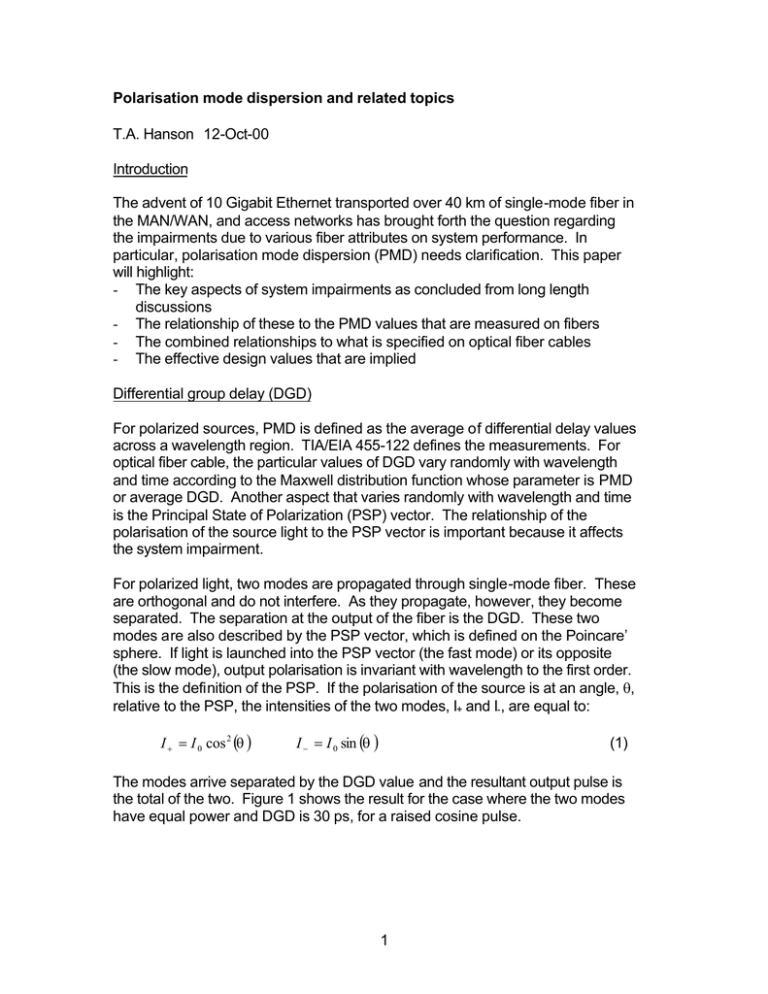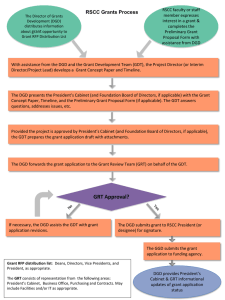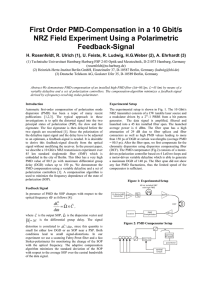Response to Exercise 1, contributed by T. A. Hanson
advertisement

Polarisation mode dispersion and related topics T.A. Hanson 12-Oct-00 Introduction The advent of 10 Gigabit Ethernet transported over 40 km of single-mode fiber in the MAN/WAN, and access networks has brought forth the question regarding the impairments due to various fiber attributes on system performance. In particular, polarisation mode dispersion (PMD) needs clarification. This paper will highlight: - The key aspects of system impairments as concluded from long length discussions - The relationship of these to the PMD values that are measured on fibers - The combined relationships to what is specified on optical fiber cables - The effective design values that are implied Differential group delay (DGD) For polarized sources, PMD is defined as the average of differential delay values across a wavelength region. TIA/EIA 455-122 defines the measurements. For optical fiber cable, the particular values of DGD vary randomly with wavelength and time according to the Maxwell distribution function whose parameter is PMD or average DGD. Another aspect that varies randomly with wavelength and time is the Principal State of Polarization (PSP) vector. The relationship of the polarisation of the source light to the PSP vector is important because it affects the system impairment. For polarized light, two modes are propagated through single-mode fiber. These are orthogonal and do not interfere. As they propagate, however, they become separated. The separation at the output of the fiber is the DGD. These two modes are also described by the PSP vector, which is defined on the Poincare’ sphere. If light is launched into the PSP vector (the fast mode) or its opposite (the slow mode), output polarisation is invariant with wavelength to the first order. This is the definition of the PSP. If the polarisation of the source is at an angle, θ, relative to the PSP, the intensities of the two modes, I+ and I-, are equal to: I + = I 0 cos 2 (θ ) I − = I 0 sin (θ ) (1) The modes arrive separated by the DGD value and the resultant output pulse is the total of the two. Figure 1 shows the result for the case where the two modes have equal power and DGD is 30 ps, for a raised cosine pulse. 1 Raised cosine modified by DGD & PSP 1.2 1 0.8 Slow Power 0.6 Fast Total 0.4 Ideal 0.2 0 -150 -100 -50 0 50 100 150 -0.2 Time Figure 1: DGD = 30 ps, equal power Note that the peak of the total is reduced compared to the ideal and the width of the total is greater than ideal at values outside of ± 50 ps. Figure 2 shows the result for θ = π/8 (power ratio of 0.17). Raised cosine modified by DGD & PSP 1.2 1 0.8 Power Slow 0.6 Fast 0.4 Total Ideal 0.2 0 -150 -100 -50 0 50 100 150 -0.2 Time Figure 2: DGD = 30 ps, Unequal Power Figure 3 shows the ideal and total from Figure 2 when the time axis of total has been adjusted so the maximum of the two curves are aligned. 2 Raised cosine with Wander adjustment 1.2 1 Power 0.8 Ideal 0.6 Total(adj) 0.4 0.2 0 -150 -100 -50 0 50 100 Time Figure 3: Total from Figure 2 adjusted in time Close inspection of Figure 3 will show that that the total curve is not as much reduced from ideal as Figure 1 and that the width is also smaller than the width in Figure 1. Some might conclude that the effect of the curve seen in Figure 2 would imply, in effect, excess jitter. Long distance receivers, however, have automatic clock adjustments for the changes in overall differential delay due to, for example, temperature changes of the installed plant or drift in the triggering clock of the source. These controllers can also make the adjustments needed to accommodate the shift in the overall pulse due to changes in either DGD or PSP over time. In effect these PMD induced changes are treated as Wander vs. Jitter because the PMD characteristics change slowly [on the order of hours].with time. Power Penalty Poole [1] did early work on studying the impairments associated with DGD and the relationship of the source polarisation vs. the PSP for non-return-to-zero (NRZ) formats. From these studies, he concluded that the power penalty (probably vertical) could be determined from the following formula: ∆τ dBQ ( PMD ) = A γ (1 − γ ) T 2 ∆τ T γ (2) Instantaneous DGD (ps) Bit period (ps) Instantaneous power splitting ratio with values from 0 to 1 3 A Factor relating to temporal pulse shape as: Pulse Shape Gaussian Raised cosine Square 25% Rise-fall A 25 22 12 15 Studies done since that time using amplified detectors such as APDs have led to the conclusion that the actual receiver sensitivity penalty (power penalty), ε, is twice as large as indicated by equation 2. That is: ε = 2 • dBQ ( PMD ) (3) This adjustment could also be caused by the combined effects of vertical and horizontal eye-closure. Namihira [2] did confirmation studies by measuring the actual bit error rate (BER) and the amount of additional power needed to restore a given level as a function of DGD. For NRZ formats, his results are in very good agreement with the combination of equations 2 and 3 for raised cosine and power splitting ratio of 0.5. He also completed experimentation for RZ formats. For RZ, the penalty is lower than NRZ at almost all DGD levels. Since Namihira’s results are based on BER and power, they combine the impairments of both vertical and horizontal eye closure. An interpretation of power penalty is that if the system is designed to have additional power (compared to the power required for all other factors) equal to the design power penalty, the system will operate at or within the design BER. Probability DGD varies according to the Maxwell probability density function which has the PMD value as the single defining parameter. The probability that an actual DGD values exceeds a given value can be related to its the ratio with the PMD value. This ratio is often called S (safety). Some probabilities associated with various S values are found in table 1. 4 Table 1 Probability based on wavelength average S Probability 3.0 4.2E- 05 3.1 2.0E- 05 3.2 9.2E- 06 3.3 4.1E- 06 3.4 1.8E- 06 3.5 7.7E- 07 3.6 3.2E- 07 3.7 1.3E- 07 3.775 6.5E- 08 3.8 5.1E- 08 3.9 2.0E- 08 4.0 7.4E- 09 4.1 2.7E- 09 4.2 9.6E- 10 4.3 3.3E- 10 4.4 1.1E- 10 4.5 3.7E- 11 Without taking the mode power ratio into account (assuming it to be equal to 0.5), the interpretation of these probabilities is in terms of potential unavailability. That is, one assumes that if the actual DGD is less than a value associated with the design power penalty, then the system will operate to the design BER. If this design value is exceeded, the system could become unavailable (down) for the time over which this occurs. This potential unavailability is given by the following equation, scaled to minutes/year/circuit (probability times twice the number of minutes per year). Unavail = 2 • 365.25 • 24 • 60 • Pr obability (4) For example an S-value of 3, which is used by many for design, would imply 44 min/yr/cir potential downtime if equation 4 alone were used. Others have proposed a design S-value of 3.7 which would imply 0.13 min/yr/cir potential downtime. The maximum allowed total PMD value can be computed for either scenario by dividing the maximum design DGD by the S-value. Poole [1] concluded that the maximum allowed PMD computed by simple division could be further refined by taking into account the variation in the varying relationship of the source polarisation and the randomly varying PSP. This 5 random variation can be taken into account by assuming that the power splitting ratio is varying randomly according to a uniform distribution between zero and one. To take both Maxwell variation of DGD and power splitting ratio into account, Poole completed a convolution of the two. The convolved probability density function of ε (from equation 3) is given in terms of a combined parameter, η, as : f (ε ;η ) = η exp (− ηε ) where η = 8 T Aπ < ∆τ > (5) 2 where < ∆τ > is the DGD expected value (wavelength average), or PMD value. Poole used equation 5 to set a maximum PMD to generate not more than a defined power penalty at a specified probability. This maximum value is greater than the value calculated using table 1 alone. While this methodology is compatiable with the notion of a fixed maximum, it is not exactly compatible with the statistical PMD specification that is outlined below. For the statistical PMD specification, Poole’s convolution formula is used to reduce the potential unavailability associated with a given maximum PMD specification rather than to extend the PMD specification for a given unavailability. Statistical specification of PMD Because PMD is the average of random values, the PMD value that one obtains from measurements is somewhat random. Gisin [3] concluded that the limit was about 15% of the mean. For this reason, as well as the fact that PMD measurements are generally sampled, the cable manufacturers concluded that some sort of statistical specification should be adopted. There are two forms of specification that are defined in the proposed revision of IEC 60794-3 (outdoor cable) [ballot 86A/570/CDV] and the Determined (as of April, 2000) Revision to ITU-T Recommendation G.652 (Unshifted single-mode fiber and cable). These documents also contain guidance on calculation methodologies. The published TIA/EIA TSB 62-109 gives similar guidance. IEC 61282-3 repeats the guidance for optical fiber cable and adds methodologies for adding other PMD generating network elements such as optical amplifiers and dispersion compensating devices to the calculations. One outcome of adding these components is that the probability requirements for DGD exceeding a given value are reduced by a factor of two for the probability requirements of both optical fiber cable and components. Gigabit Ethernet does not currently 6 include such components so the situation is simplified and the probability requirements should be less stringent. The two specification methods are complementary in that the default values are chosen so that if the specification is met for Method 1, the design implications of Method 2 are satisfied. Method 1 is based on PMD coefficient values (ps/sqrt(km)) that can be measured. Method 2 is focused on the maximum DGD and probability of exceeding it for the reference system length. Method 1 is specified. Method 2 is implied. Method 1 defines a parameter, PMD Q, sometimes called the Link Design Value (LDV), as the 99.99 percentile of the PMD coefficient of the concatenation of 20 cable sections that could be randomly drawn from the process distribution. The default specification value in both IEC and ITU-T is: PMDQ ≤ 0.5 ps / km (6) While the LDV is more easily understood than Method 2, it has certain limitations. One of which is illustrated in Figure 4. Figure 4 shows a number of distributions that all pass the specification. Distributions toward the left, however, which are probably more representative of actual distributions, will clearly yield a tighter distribution of DGD values than the distributions toward the right. Various passing distributions 0.07 Relative frequecy 0.06 0.05 0.04 0.03 0.02 0.01 0 0 0.1 0.2 0.3 0.4 0.5 0.6 Concatenated link PMD coefficient Figure 4 – Distributions passing PMD Q requirements Given the PMD Q spec alone, it is difficult to determine the maximum DGD and probability. Another limitation of the LDV is that it is applicable to links which are concatenations of 20 or more cable sections. While this is generally a conservative assumption for long distance links, it becomes a question for links 7 of 40 km where there may be a concatenation of only 4 cable sections (of 10 km each). Method 2 is based on requiring the probability that the DGD of a 400 km link (comprised of 40 10 km cable sections) exceeding a certain value, DGDmax, be less than a certain value. The default limits are: DGDmax 25 ps Probability ≤ 6.5•10-8 When optical fiber cable is combined with optical components that generate PMD, the combined probability doubles to 1.3•10-7. These values were chosen partly on the basis of a 30 ps end-to-end combined maximum DGD, which corresponds to 1 dB power penalty. They were also chosen because of an equivalence, defined in the guidance standards, to the Method 1 requirement. The values are much lower than one would expect based on the multiplier rules discussed above in conjunction with the S-values of Table 1 because the probability is calculated from the convolution of the distributions of Figure 4 and the Maxwell distribution variation of DGD. The equivalence is derived from studying the effective average and standard deviation parameters of the distributions in Figure 4. Given these parameters which, one can calculated whether the Method 1 requirement is passed or failed. A curve, or envelope, can therefore be constructed, with the x-axis representing the process “average” and the y-axis representing the process “standard deviation.” Process distributions that have these parameters falling below the envelope pass the requirement. The same can be done for the Method 2 requirement. When the two envelopes overlap, there is equivalence. Figure 5 shows the situation for the default Method 1 and Method 2 requirements. 1/2sqrt(beta) (ps/sqrt(km)) Equivalence envelopes for Method 1/2 defaults 0.8 0.7 0.6 0.5 0.4 0.3 0.2 0.1 0 0 0.1 0.2 0.3 0.4 Quadrature average (ps/sqrt(km)) M2: 25 ps, Pr: 6.5e-8, 400 km, 10km cable M1: 0.5 ps/sqrt(km), Pr: 1e-4, 20 cables Figure 5: Equivalence diagram for long distance 8 One can there conclude that if the default Method 1 requirement is met, one can safely design with the default values of Method 2. What about links of shorter length but still comprised of cable section lengths less than or equal to the 10 km design value? It has been shown that the Method 2 values are conservative for any length less than 400 km. For longer links, it has also been shown that a new calculated DGDmax based on the square root of the ratio of lengths is also conservative. For 10 Gigabit Ethernet, the above values are conservative. The question remains: how conservative. Application of the equivalence methodology to a series of possible DGDmax values for probability equal to 1.3•10-7 is shown in Figure 6. Figure 6 – Equivalence diagram for 40 km This set of curves shows that the DGDmax value of 19 ps can be used in conjunction with a probability value of 1.3•10-7 for links of 40 km when the default Method 1 requirement of 0.5 ps/sqrt(km) is satisfied. Mode power ratio The prior section completed the calculation for the maximum DGD at a given probability. This maximum DGD implies a maximum power penalty for power in each mode. The variability of the actual mode power ratio would, however, reduce the probability that this penalty would be exceeded to some level lower 9 than the probability that DGDmax is exceeded. Poole’s convolution formula can be rewritten in terms of the maximum DGD associated with the maximum penalty and the PMD of a member of the distribution of concatenated links. Figure 7 shows the result of the probability reduction factor as a function of the ratio of PMD to DGDmax. Power Splitting Ratio Effects 0.35 Probability Ratio 0.3 0.25 0.2 0.15 0.1 0.2 0.25 0.3 0.35 0.4 PMD/DGDmax Figure 7 : Probability reduction factor Figure 7 can be interpreted as follows: If one has defined a maximum penalty derived for equal mode power and a given DGDmax value, the actual probability is reduced from the probability that DGDmax is exceeded by the factor given on the y-axis depending the PMD of the link in question – by its ratio to DGDmax. The treble convolution with process, Maxwell, and mode power ratio could conceivably be done. Since, however, the reduction factor is decreasing with decreasing PMD values, one could use the factor for the maximum link PMD values. For the long length case, the maximum link PMD value is taken to be 0.5 ps/sqrt(km) x sqrt(400 km) = 10 ps. DGD max is 25 so PMDmax/DGDmax is 0.4, corresponding with a reduction factor of 0.4. For 10 Gigabit Ethernet, the value of 0.9 ps/sqrt(km) for the 99.99 percentile of a link comprised of four cable sections is determined to be equivalent (by the method of the prior section) to the Method 1 default requirement. PMDmax/DGDmax is therefore equal to 0.3 and the probability reduction factor is approximately 0.23. 10 This would imply that the potential unavailability is equal to 0.03 min/yr/cir – or approximately 1.9 s/yr/cir. Conclusions Following the default Method 1 specification that is being standardized – and the Method 2 equivalent for 10 Gigabit Ethernet over 40 km, the maximum DGD and probability are given as: DGDmax 19 ps Probability 1.3•10-7 For raised cosine pulses, the maximum power penalty is given as 0.4 dB (calculated for a 100 ps bit period). The probability that the maximum power penalty is exceeded is 0.3•10-7. This corresponds to potential unavailability of 1.9 s/yr/cir. Smaller values of power penalty can be achieved by increasing the potential unavailability. References 1. “Polarization Effects in Lightwave Systems”, C.D. Poole & J. Nagel, Optical Fiber Telecommunications, Vol. IIIa, Chapter 6, Lucent Technologi 2. “Proposal for PMD tolerance test of 10 Gbit/s WDM optical signal transmission performance”, Y. Namihira, ITU-T Study Group 15 Delayed Contribution D.454, October, 1998. 3. "How accurately can you measure PMD?" N. Gisin, Jnl lightwave technology, ~1997. 11





